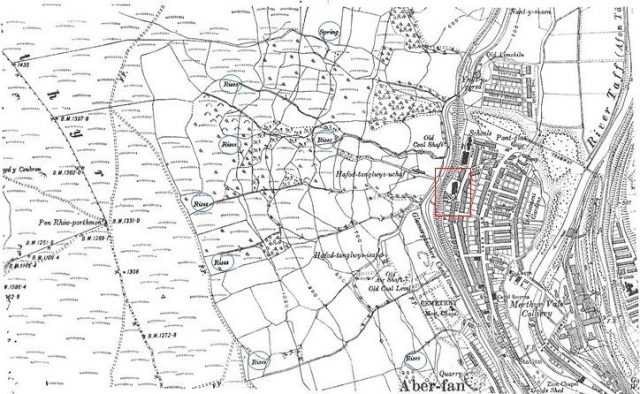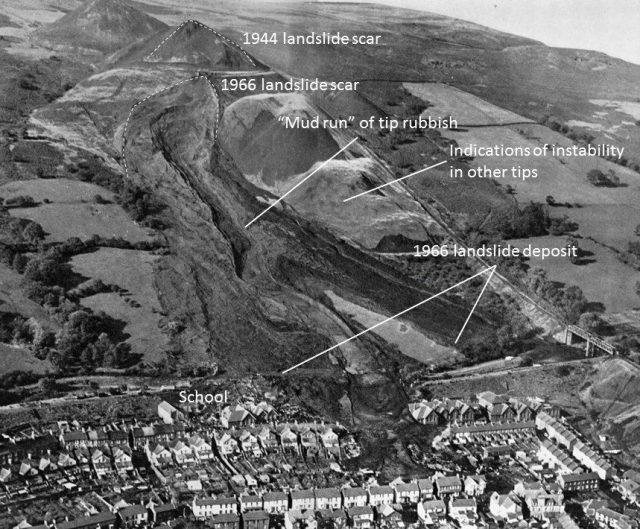19 October 2016
Aberfan: The National Coal Board failures part 2
Posted by Dave Petley
Aberfan: The National Coal Board failures part 2
Yesterday I described how the National Coal Board failed to recognise, or just ignored, the risks posed by spoil heaps, despite multiple previous failures. Some of these occurred at Aberfan itself. But this was not the only failure by the National Coal Board in the period leading up to the collapse. The Official Tribunal was also scathing about the siting of the spoil heaps at Aberfan:
With the enduring reminder of the 1944 slide so clearly visible and its causes still remaining unknown, no fresh tipping on the mountainside should have been begun without a complete survey, without boreholes, without proper drainage, and without indicating the limits of the tipping area. And even without a survey, reference to the available geological map would have revealed a line of springs at the Brithdir seam, the Ordnance Survey would have given warning of watercourses, and the site would thus have been revealed as obviously unsuitable for tipping beyond a short distance from the rail incline. Indeed, even without referring to a single map, we are satisfied that there were features clearly to be seen which should have brought home to Mr. R. N. Lewis (Colliery Manager) and Mr. Joseph Baker (Group Mechanical Engineer) how limited was the area of suitable tipping land there available to them.
So why did the Tribunal determine that the site was so unsuitable for the siting of a spoil heap? This lies at the heart of the collapse.
Britain is an exceptionally well-mapped country, such that both the mine planners and the Tribunal has access to very high quality, unbiased maps of the terrain prior to the construction of the tips. The Tribunal report included one of these maps in their analysis:

Annotated topographic map of the Aberfan site before the spoil heap was created, showing the springs (“rises”) that mantled the slope, from the Official Tribunal
.
The location of Pantglas Junior School is in red, and I have circled the multiple springs (labelled as “rises”) across the slope. Note the streams that flow down into the valley from these springs. The investigations were led by Professor A.W. Bishop of Imperial College, an authority in soil mechanics and slope behaviour. The Tribunal notes that Professor Bishop highlighted that this water contributed to the landslide in four ways:
I. Water issuing beneath the tip has caused back-sapping [this is erosion on the downslope face of the tip] and led to recurrent movements over the years since 1963.
II. Water under pressure acting in the tip material and in the limited area of the foundation where the slip surface was adjacent to the natural ground reduced the effective stresses in the fill and initiated a shear displacement. In view of the presence of pre-existing slip surface, this pressure need not have been very large.
III. Water filling (or nearly filling) the voids of the loose fill comprising the tip and covering the area of mountainside below it made it susceptible to a catastrophic flow slide, since a shear displacement or shock wave could result in the transfer of most of the load on to the relatively incompressible water in the voids, thus reducing the frictional strength to a very low value.
IV. Water released by the slip and consequent flow slide caused a ‘mud run’ of tip rubbish.”
The key mechanism is the second if course, in which the rising water level decreased the resistance to shear, allowing the slope to fail. The construction of the tips on top of the springs and their associated streams, without any means for the water to be managed, inevitably meant that water would collect in the spoil heaps. This was utter folly.
The point about pre-existing shear surface is critical – Bishop found that Tip Number 7 had been built upon waste from earlier failures, and of course had previously slipped. This meant that the materials were weaker than when freshly tipped, and so more likely to slip. But the slope was also mantled with a layer of glacial till, commonly known as boulder clay in the UK, upon which the tip had been constructed. This boulder clay may have provided an additional weak layer that allowed the tip to deform (it did not form the shear surface of the landslide itself), and it may also have prevented drainage of the water that was ponding in the tip. Finally, the role of the springs may have been exacerbated by mining disturbance, which had opened up new pathways for water to flow from the slope, probably nearer to the valley floor, and thus increased the ponding of water in the slope.
Thus, the Tribunal was clear about the failures by the National Coal Board. They highlight that it is obvious that construction of a tip on a pre-existing slope requires additional consideration, and in particular detailed site investigation. The Tribunal is clear that the National Coal Board did not undertake adequate site investigation, did not prepare the site correctly, did not plan the expansion of the tips (particularly with respect to allowing a new tip to be built on the deposit of a previous failure), and did not manage the tips in a responsible manner.
In the modern context, a basic requirement would be to undertake proper site investigation, to remove weak materials from the land surface before tipping begins, to build culverts to allow the springs to flow, to actively drain the water from the waste, to plan the tips and to monitor their stability. This has prevented repetition of this disaster in most developed countries, but as I point out in my New Civil Engineer article, water-induced failures of mine waste are still far too common in some places.
The impacts of the failures by the National Coal Board are all to clear in the image below of the failure, which I have annotated to show the main features:

Annotated aerial photograph of the Aberfan flowslide, via the Official Tribunal
.
50 years on it is hard not to be horrified by the multiple failures of management that led to this catastrophe.


 Dave Petley is the Vice-Chancellor of the University of Hull in the United Kingdom. His blog provides commentary and analysis of landslide events occurring worldwide, including the landslides themselves, latest research, and conferences and meetings.
Dave Petley is the Vice-Chancellor of the University of Hull in the United Kingdom. His blog provides commentary and analysis of landslide events occurring worldwide, including the landslides themselves, latest research, and conferences and meetings.